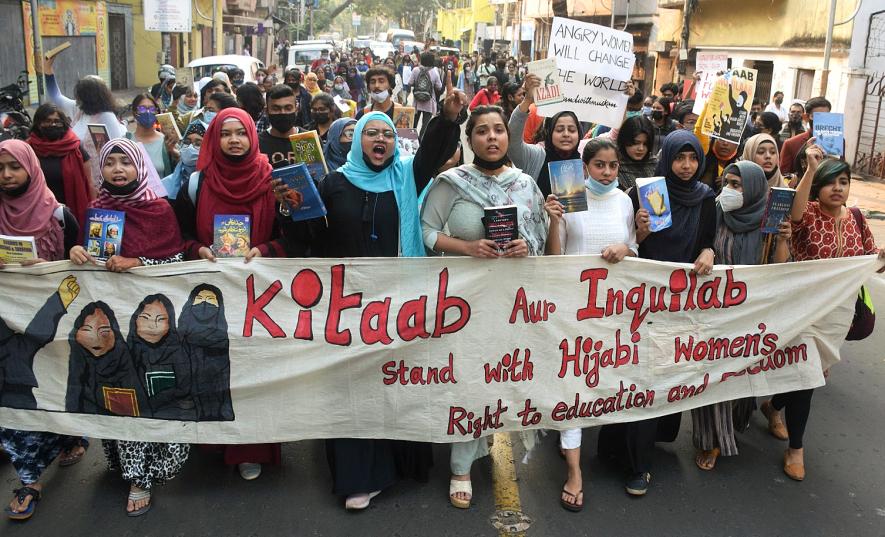Why Hindutva and Patriarchy Get Hijab Wrong

Women stage a protest over the hijab ban imposed in the few colleges in Karnataka
Since May 2014, Muslims have been the prime targets of the Hindutva juggernaut. From cold-blooded lynchings to laws poised to take away citizenship claims, Indian Muslims have suffered a nightmare unparalleled since independence. The latest ordeal opposes the hijab or headscarf many Muslim women wear. Ironically, the opposition comes from Hindutva forces who hang on to social obscurantism and conservatism of every shade.
The hijab is undoubtedly a patriarchal imposition on women. But that is not even the issue here—the debate here began with demands to wear hijab inside classrooms. That said, Hindutva-inspired Islamophobia, chiefly emanating from imperialist America and its European allies, tends to attribute hijab and burqa only to the Muslims. In reality, veiling preceded the birth of Islam. It was so because patriarchy preceded Islam. Before Islam, the Sassanian women of West Asia wore a veil, as did Christian communities during the Byzantine period in the Mediterranean. Assyrian law coded the rules of veiling women to the extent of specifying who must veil and who cannot. For instance, the wives of nobles had to veil, as did concubines and former ‘sacred prostitutes’ who were now married. Slave women were not required to veil.
Similarly, in north-western India, ghunghat among women is a common practice that imposes passive and submissive behaviour in encounters with senior males and females. In the 1970s, it was estimated that nearly 72.61% of women in Haryana observed ghunghat. A clear recent indication that things have not changed is the advertisement issued in 2017 by the Haryana government-owned magazine, Krishi Samvad. In it, a caption to a photograph of a veiled woman read, “Ghoonghat ki aan-baan, mhara Haryana ki pechchan—Pride in the veil is the identity of my Haryana.”
In her book Women and Gender in Islam, Leila Ahmed notes that during Prophet Mohammad’s lifetime, wives were the only Muslim women required to veil and that only toward the end. She argues it was only after Mohammad’s death and the subsequent Islamic conquests of adjoining territories where the upper-class women veiled that the veil became a commonplace item of clothing among Muslim upper-class women. In other words, this veiling of Mohammad’s wives became a model practice Muslims generally adopted.
The debate about the Quranic sanction of the veil is an abstruse one and is better left to the keepers of the faith. While the Karnataka High Court is poised to decide whether the Quran sanctions the hijab or not, it is bound to be a divisive exercise. What if the court ignores the multitude of interpretations of the holy book and disqualifies the veil as essential to Islam, as it did the mosque in the Babri ruling? And what if it decides the veil is an essential practice to Islam? Would that mean all women of the faith would have to wear one?
Be that as it may, the Bharatiya Janata Party (BJP) has again succeeded in bringing to the table the debate of Muslim backwardness for its Hindutva idlers, as it did with the triple talaq bill. The perils of this are twofold: firstly, it leaves the conservatism and social backwardness of the majority community untouched. If we go by Jawaharlal Nehru’s famous dictum, if the communalism of the majority is far more dangerous than that of the minority, then the conservatism of the majority is a much more severe social impediment than of the minority. By leaving the symbols of patriarchal imposition among the Hindu women intact, Hindutva has brewed a dangerous broth.
Secondly, this has strengthened the conservative forces within Muslims, whose vice grip is yet to face a formidable challenge from within the fold. Their earlier patriarchal retorts insisting women wear the hijab have now assumed a resistance character. In other words, far from being an imposed symbol of feminine modesty, wearing the hijab has become a token of resistance against Hindutva.
The clear winners of this inglorious bout are the forces of Hindutva and the Islamists. Still, its nature is pyrrhic. Because whatever gains Hindutva might be poised to make would ultimately be employed against the Muslims as a community. Put another way, since Hindutva does not distinguish between a Shahrukh Khan and a Pehlu Khan, the Muslims as a community are up against another ordeal.
Secularists and progressives must tread very carefully. More than three decades ago, the Hindutva forces capitalised on the overturning of the Shah Bano judgment by the Rajiv Gandhi-led Congress government. They succeeded in creating the binary of the ‘appeased’ Muslim vis-à-vis an ‘aggrieved’ Hindu and built an entire movement out of a local and unfounded belief that Lord Rama was born on the exact place where the Babri Masjid stood. Today, Hindutva has succeeded in building the Rama temple and yet remains thirsty for the blood of the Muslims. Any support for the hijab is bound to be construed as an attempt towards Muslim appeasement.
In such a situation, the task before the progressives is twofold. Firstly, the defence of the Muslim identity must precede the support for the hijab. The message needs to be coded in a manner that does not support those who see the hijab as necessary for Muslim females. Secondly, a conjugated public campaign must start against patriarchy led by feminists of all shades to set the agenda for women’s emancipation. Only then a cross-religion unity between Hindu and Muslim women could be established that would not be prone to the artificial communal acrimony that Hindutva relentlessly seeks to foster.
The author is an independent research scholar. The views are personal.
Get the latest reports & analysis with people's perspective on Protests, movements & deep analytical videos, discussions of the current affairs in your Telegram app. Subscribe to NewsClick's Telegram channel & get Real-Time updates on stories, as they get published on our website.























